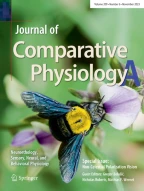Summary
-
1.
Euphausiid eyes have all the features of classical refracting superposition eyes. The crystalline cones, which resemble those of moths very closely, are hard, circular in cross section and hexagonally packed. They are thus unlike the optical elements of macruran decapods with reflecting superposition optics, which are soft and square in section.
-
2.
The clear zone always has a thickness of about half the local radius of curvature of the eye, when the centre of curvature is defined as the point of intersection of the axes of the cones. This zone appears to contain only the clear cytoplasm of the receptor cells, and there are no structures that could be considered to be light-guides.
-
3.
It is shown that the crystalline cones have the property of bending incident light across their axes, so that it emerges into the clear zone at an angle equal and opposite to the angle of incidence at the eye surface. This is a necessary condition for superposition image formation.
-
4.
Many deep-water euphausiids have double eyes, usually with a region of enlarged facets pointing upwards and covering a narrow angle, and a downward pointing region covering a wider angle. The upper eye often has a peculiar geometry, with the eye surface centred on a point in the receptor layer, but the long axes of the cones centred on a point twice as deep in the eye. It is shown that this condition produces a superposition image with no axial spherical aberration.
-
5.
A consequence of this arrangement is that the focal plane is flat, not curved as in spherical-eyed forms, and this explains why the retina has a flattened appearance in the upper but usually not the lower eyes.
-
6.
Unlike the eyes of both moths and macruran decapods, euphausiid eyes do not show eye-shine. The rhabdoms are relatively short and wide, and are not shielded by reflecting pigment.
Similar content being viewed by others
References
Baker, A. de C.: The vertical distribution of euphausiids near Fuerteventura, Canary Islands (‘Discovery’ Sond Cruise, 1965). J. Mar. Biol. Ass. U.K.50, 301–342 (1970)
Ball, E.E.: Fine structure of the compound eyes of the midwater amphipodPhronima in relation to behavior and habit. Tissue Cell9, 521–536 (1977)
Brinton, E.: Euphausiids of Southeast Asian waters. Naga Report Vol. 4, Part 5. La Jolla: Scripps Institution of Oceanography 1975
Bruno, M.S., Barnes, S.N., Goldsmith, R.H.: The visual pigment and visual cycle of the lobsterHomarus. J. comp. Physiol.120, 123–142 (1977)
Chun, C.: Atlantis. Biologische Studien über pelagische Organismen. Zoologica, Stuttgart7, 1–260 (1896)
Cleary, P., Deichsel, G., Kunze, P.: The superposition image in the eye ofEphestia kühniella. J. comp. Physiol.119, 73–84 (1977)
Exner, S.: Die Physiologie der facettirten Augen von Krebsen und Insecten. Leipzig und Wien: Deuticke 1891
Fletcher, A., Murphy, T., Young, A.: Solutions of two optical problems. Proc. R. Soc. Lond. A223, 216–225 (1954)
Horridge, G.A.: Optical mechanisms of clear-zone eyes. In: The compound eye and vision of insects. Horridge, G.A. (ed.), pp. 255–298. Oxford: Clarendon 1975
Horridge, G.A., Giddings, C., Stange, G.: The superposition eye of skipper butterflies. Proc. R. Soc. Lond. B182, 457–495 (1972)
Horridge, G.A., McLean, M., Stange, G., Lillywhite, P.G.: A diurnal moth superposition eye with high resolution:Phalaenoides trisifica (Agaristidae). Proc. R. Soc. Lond. B196, 233–250 (1977)
Kampa, E.M.: The euphausiid eye—a re-evaluation. Vision Res.5, 475–481 (1965)
Kirschfeld, K.: The absolute sensitivity of lens and compound eyes. Z. Naturforsch.29c, 592–596 (1974)
Kirschfeld, K.: The resolution of lens and compound eyes. In: Neural principles in vision. Zettler, F., Weiler, R. (eds.), pp. 354–370. Berlin, Heidelberg, New York: Springer 1976
Kuiper, J.W.: The optics of the compound eye. Symp. Soc. Exp. Biol.16, 58–71 (1962)
Kunze, P.: Comparative studies of arthropod superposition eyes. Z. vergl. Physiol.76, 347–357 (1972)
Land, M.F.: The physics and biology of animal reflectors. Prog. Biophys. Mol. Biol.24, 75–106 (1972)
Land, M.F.: Superposition images are formed by reflection in the eyes of some oceanic decapod crustacea. Nature263, 764–765 (1976)
Land, M.F.: Optics and vision in invertebrates. In: Handbook of sensory physiology, Vol VII/6B. Autrum, H. (ed.), Berlin, Heidelberg, New York: Springer (in press) 1979
Meyer-Rochow, V.B.: The eyes of mesopelagic crustaceans. II.Streetsia challengeri (Amphipoda). Cell Tiss. Res.186, 337–349 (1978)
Meyer-Rochow, V.B., Walsh, S.: The eyes of mesopelagic crustaceans: III.Thysanopoda tricuspidata (Euphausiacea). Cell Tiss. Res.195, 59–79 (1978)
Seitz, G.: Untersuchungen am dioptrischen Apparat des Leuchtkäferauges. Z. vergl. Physiol.62, 61–74 (1969)
Vogt, K.: Zur Optik des Flußkrebsauges. Z. Naturforsch.30c, 691 (1975)
Vogt, K.: Ray path and reflection mechanisms in crayfish eyes. Z. Naturforsch.32c, 466–468 (1977)
Author information
Authors and Affiliations
Rights and permissions
About this article
Cite this article
Land, M.F., Burton, F.A. & Meyer-Rochow, V.B. The optical geometry of euphausiid eyes. J. Comp. Physiol. 130, 49–62 (1979). https://doi.org/10.1007/BF02582973
Accepted:
Issue Date:
DOI: https://doi.org/10.1007/BF02582973
